Creative Commons Licenses
Learning Objectives
By the end of this chapter, you will be able to:
- Describe the four different Creative Commons License components.
- Explain the strengths and weaknesses of the most common Creative Commons licenses.
- Explain why some CC-licensed content might not be considered OER.
Creative Commons (CC) licenses allow you to explain, in plain language, how your creative works can be reused. These licenses act as explicit, standing permissions for all users.
The Four Components of Creative Commons Licenses
| Attribution (BY) Proper attribution must be given to the original creator of the work whenever a portion of their work is reused or adapted. This includes a link to the original work, information about the author, and information about the original work’s license. | |
| Share-Alike (SA) Iterations of the original work must be made available under the same license terms. | |
| Non-Commercial (NC) The work cannot be sold at a profit or used for commercial means such as for-profit advertising. Copies of the work can be purchased in print and given away or sold at cost. | |
| No Derivatives (ND) The work cannot be altered or “remixed.” Only identical copies of the work can be redistributed without additional permission from the creator. |
These elements can be mixed and matched to create a total of six Creative Commons licenses.[1]
Choosing a License
Choosing a CC license can initially be confusing, but the online Choose a License tool can help. This tool generates a license based on which rights the author wants to retain and which the author wants to give to users. For example, if the author wants to share their work and allow others to adapt it, but they do not want others to be able to sell their work, they might consider using the CC BY NC license.
Before the author can choose a license, they should remember that an OER should be able to exercise all the 5 Rs of open content discussed in the previous chapter. Not all CC licenses meet this definition. Specifically, the CC BY-ND and CC BY NC ND licenses do not allow revising or remixing content, two of the most significant freedoms of OER for many instructors.
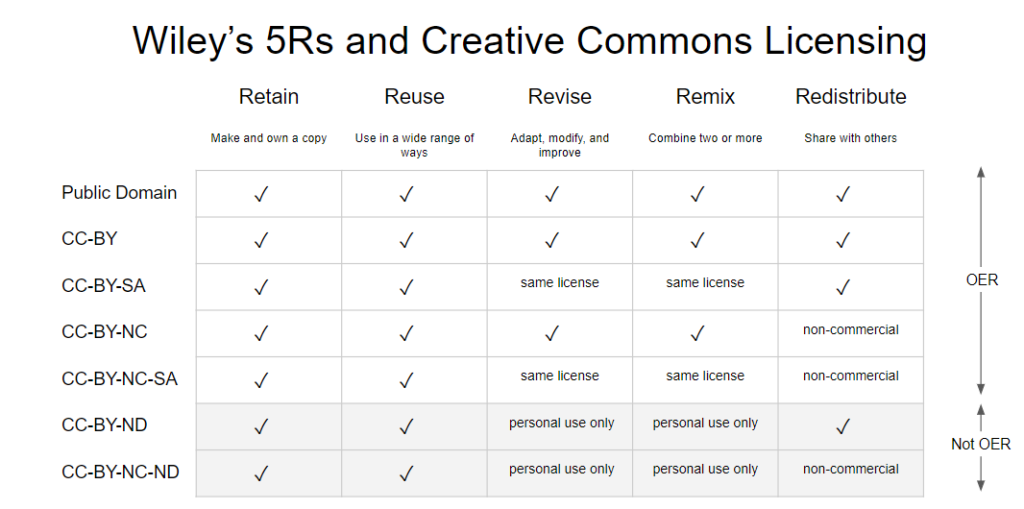
The Four “Open” CC Licenses
There are six licenses in total, but only four are considered open. These are listed below. There are strengths and weaknesses to each Creative Commons license an author might apply to their OER. To help you learn more, a short description of each license that can be applied to OER is provided below. Please note that you are not expected to advise on CC licensing in this role. This is just for interest’s sake.
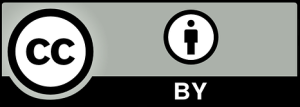 CC BY
CC BY
Strengths
- The CC BY license is the most popular and open license provided by Creative Commons.
- By requiring attribution and nothing else, your CC BY work will be easy for others to adapt and build upon.
- CC BY is often the default choice for open publications. YouTube uses the CC BY 3.0 license as its single “Creative Commons” option.
Weaknesses
- Because CC BY allows for easier sharing and adaptation, the creator has less power over their work. When you use a CC BY license, you cannot be certain that your work will remain open or that your work will be reused for projects you support.
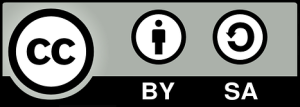 CC BY SA
CC BY SA
Strengths
- The CC BY SA combines the openness of a CC BY license with the caveat that an item remains open under the same license when adapted.
- The CC BY SA license is the second most popular license, and the license is used by Wikipedia for its articles.
Weaknesses
- Because the CC BY SA license requires that adapted content be shared under the same license, it can be difficult to adapt or to remix works licensed CC BY SA.[2]
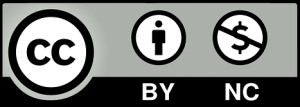 CC BY NC
CC BY NC
Strengths
- The CC BY NC license gives the creator of a work complete control over any commercial reuse of their work.
- As a user, you can adapt and remix CC BY NC works so long as your new works provide attribution to the original author and do not turn a profit.
Weaknesses
- Some users may be concerned about what they can do with your CC BY NC work and where the commercial “line” is drawn.
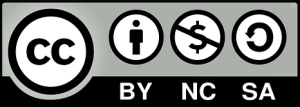 CC BY NC SA
CC BY NC SA
Strengths
- CC BY NC SA is the most restrictive license that can be used for OER and gives you the most control over its adaptations.
- Some creators apply for this license out of concern for their works being “scooped” by commercial publishers.
Weaknesses
- Because of its requirements, the CC BY NC SA license is the hardest to adapt, remix, or build upon.
- If you hope to leverage the open community to promote and share your content, this license may deter potential partners.
You can learn more about the individual CC licenses on the Creative Commons website.
Chapter Summary
Check Your Understanding
A set of open licenses that allow creators to clearly mark how others can reuse their work through a set of four badge-like components: Attribution, Share-Alike, Non-Commercial, and No Derivatives.

